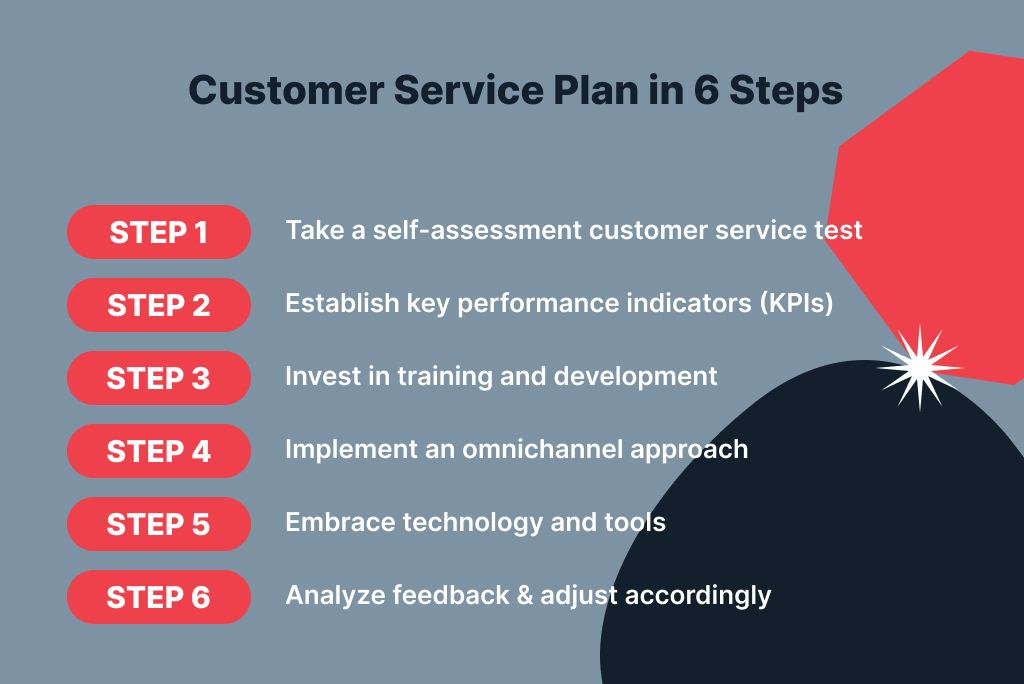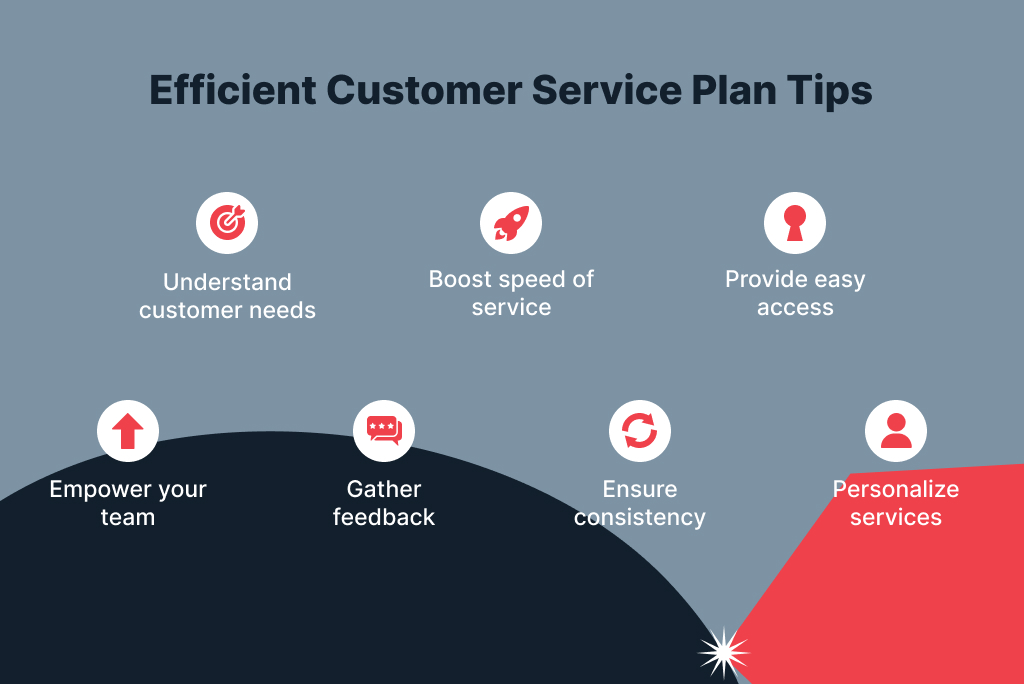We offer the expertise and support to do just that. Contact us for comprehensive customer support services that will set your brand apart.

Businesses need customer care plans to achieve efficient customer management. The process of developing them faces resistance from people who believe a plan requires too much time and offers no value.
The process of developing a customer service plan proves to be less complicated than most people anticipate. Our guide provides essential information about customer service plans and demonstrates how to create a plan that matches your business requirements.

What is customer care plan and its importance?
To understand the importance, you first need to know what a customer service plan is. A customer care plan serves as a document that explains how a company will deliver support to its customers while showing appreciation for their value. The business strategy outlines its methods for customer listening and problem-solving and its approach to delivering high-quality customer satisfaction.
The plan requires a specialized team to handle customer inquiries and optimize support operations. It guarantees customers receive satisfactory experiences from the company's products and services.
Organizations create customer care plans to build enduring connections with their customer base.
A customer care plan is also important because:
- The plan establishes specific targets for customer service operations.
- The organization maintains complete staff dedication to delivering superior customer satisfaction.
- The company ensures open communication with customers through prompt delivery of precise information.
- The organization trains staff members to deliver superior customer service while maintaining continuous learning remains a priority.
- The business collects customer feedback to enhance its customer support services through action-based implementation.
- The organization gives staff members the authority to handle customer complaints effectively.
- The company delivers consistent high-quality customer experiences through all customer contact points.
- The company handles customer complaints quickly to maintain customer satisfaction levels.
- The organization uses technology to achieve efficient and structured communication operations.
- The organization takes proactive steps to handle emerging issues before they reach critical stages.
- The system allows customers to solve their problems independently.
- The plan undergoes periodic assessments to determine its success in delivering customer satisfaction which leads to necessary adjustments.
A complete customer care plan appears challenging to implement, yet businesses can successfully establish it. Your plan development process will succeed when you analyze all relevant factors to create a solution that benefits your customers and staff and drives business success.
How to create a customer service plan step by step?
The first step to create an effective customer service business plan requires you to determine the level of importance your organization places on customer satisfaction. Your organization needs to conduct a complete self-evaluation to determine its level of commitment toward customer happiness.

Step 1: Take a self-assessment customer service test
In the book, The Customer-Driven Company by Richard C. Whiteley, the author discusses a self-assessment customer service test that helps businesses understand how well they serve their customers.
Richard’s test is a good way to understand your customers’ needs, preferences, and pain points. It is like a set of questions or evaluations to check how well a company takes care of its customers. The goal is to figure out where the company excels and where it can make improvements.
There are five ratings to determine the quality of service your business provides to customers. These are:
- Are you kidding? (Lowest rating)
- Hardly ever
- Sometimes
- Usually
- It’s our way of life! (highest rating)
Strive for a score of 4 or 5, indicating your business prioritizes and excels in customer service.
The self-assessment customer service test
The assessment contains multiple questions which help you understand your customer service approach better.
The assessment evaluates service culture dedication, customer need alignment, problem-solving abilities, data management, outreach activities, team competence, and continuous service development.
The following table shows Richard's test results in an organized format for easy use. Use the rating scale to assess each statement before determining your final score through division of total points by the number of questions.
| Our culture | Rating (1-5) |
| 1. We’re committed to doing whatever it takes to create satisfied customers. | (____) |
| 2. We strive to do things right the first time. | (____) |
| 3. As the owner, I exemplify that customer service is important. | (____) |
| 4. Serving our customers’ needs takes priority over meeting our internal needs. | (____) |
| Total Score divided by 4 | ____ |
| Customer alignment | Rating (1-5) |
| 1. When we sell, we aim for a partnership approach. | (____) |
| 2. In our marketing materials, we don’t promise what we can’t deliver. | (____) |
| 3. We understand the features and benefits that matter most to our customers. | (____) |
| 4. We design new products/services based on information provided by our customers. | (____) |
| Total Score divided by 4 | ____ |
| Problem-solving | Rating (1-5) |
| 1. We review customer complaints. | (____) |
| 2. We constantly ask our customers for feedback. | (____) |
| 3. We regularly look for ways to eliminate errors based on customer input. | (____) |
| Total Score divided by 3 | ____ |
| Using customer information | Rating (1-5) |
| 1. We’ve determined what our customers expect from us. | (____) |
| 2. We frequently interact with our customers. | (____) |
| 3. All employees know what’s important to our customers. | (____) |
| Total Score divided by 3 | ____ |
| Customer outreach | Rating (1-5) |
| 1. We make it easy for our customers to deal with us. | (____) |
| 2. We aim to resolve all customer complaints. | (____) |
| 3. We encourage "wowing the customer." | (____) |
| Total Score divided by 3 | ____ |
| Qualified and empowered staff | Rating (1-5) |
| 1. I respect my employees. | (____) |
| 2. All employees firmly understand our product/service. | (____) |
| 3. All employees possess the right tools and skills to perform their jobs well. | (____) |
| 4. All employees are encouraged to resolve customer issues. | (____) |
| 5. All employees feel that customer satisfaction is part of their job. | (____) |
| Total Score divided by 5 | ____ |
| Improving products/services and processes | Rating (1-5) |
| 1. We constantly work to improve our processes and products. | (____) |
| 2. Company units communicate and cooperate to solve problems and accomplish objectives. | (____) |
| 3. When we uncover problems, we try to resolve them quickly. | (____) |
| Total score divided by 3 | ____ |
Review your test results to determine whether your score indicates high or low performance.
Your customer service needs improvement when your test results show a low score. You should direct your efforts toward the weak areas by implementing training programs and adjusting operational procedures.
Your high score indicates outstanding customer priority management. Your organization demonstrates superior customer prioritization skills which allows you to move forward with developing your customer service strategy.
Step 2: Establish key performance indicators (KPIs)
Your customer service strategy requires specific Key Performance Indicators (KPIs) to monitor its operational effectiveness. The indicators help organizations measure both customer satisfaction levels and their support team operational performance.
The essential KPIs for assessment include CSAT scores and NPS ratings and resolution speed, and first-contact resolution achievement rates.
However, we recommend you to establish all the following KPIs to do customer service planning better:
- CSAT score shows how satisfied customers are with their support experience.
- NPS score shows how likely customers are to suggest your service to others.
- Resolution Times metric shows how fast your team handles support requests because it directly affects customer satisfaction levels.
- First-Contact Resolution Rate shows how often customers receive problem solutions during their initial support interaction.
- Abandon Rate measures how often customers stop their support requests before completion. A high rate indicates issues with the support process.
- Cost per Resolution metric assesses the operational efficiency of your team when handling customer problems.
- Customer Lifetime Value estimates the total profit a customer will bring over their relationship with your company, indicating long-term satisfaction and value.
- Conversion Rate shows how well your business transforms website visitors into paying customers which demonstrates your ability to attract and keep customers.
- Escalation Rate shows the percentage of service requests that need support at levels higher than the first contact point.
- Repurchase Rate shows how often customers return to buy again which demonstrates their contentment with your products and services.
Step 3: Invest in training and development
Your team requires three fundamental competencies, which include problem-solving abilities and effective communication skills, and thorough product knowledge. This ensures your customers consistently receive exceptional support.
Here are some simple strategies we use for agent training at our inbound call center outsourcing company—and recommend you use:
- Your team members need training in three fundamental competencies which include problem-solving skills and communication abilities and product mastery.
- The training program should adapt to individual requirements by showing staff how to handle challenging situations.
- Encourage continuous learning through online courses or workshops.
- The organization should implement technology to develop interactive learning programs and obtain customer feedback for improving its training initiatives.
- The team requires complete product understanding to deliver superior customer service.
- Your organization should show appreciation to staff members through recognition programs. The training program should reward top performers while maintaining short sessions that keep participants engaged.
- Your team needs to stay updated about industry developments because this knowledge enables them to deliver superior customer service.
Your organization can improve team performance through these specific areas which will result in better customer need fulfillment.
Simply Contact dedicates itself to continuous agent training, which prepares each new hire for their first project assignment. Our approach includes specialized training sessions tailored to both call center projects for startups and enterprises. Our agents receive complete training which enables them to provide top-notch customer service to clients.
Our approach focuses on continuous learning and development which allows us to maintain high-quality support services while building trust with clients as their customer service partner.
Step 4: Implement an omnichannel approach
With an omnichannel strategy, companies ensure customers enjoy smooth, consistent interactions across both online and offline channels. Your business needs to determine all available contact channels which include phone support, email, live chat, and social media platforms.
Your organization needs to create strategies which will maintain uniform service quality across every communication channel. You should maintain identical service standards throughout all customer contact points.
The example of Simply Contact demonstrates the commitment to delivering seamless customer experiences through any contact method. Our organization strives to create effortless customer interactions through all available contact channels. We support omnichannel customer service through multiple contact channels which include online support, phone assistance, email, live chat, and social media platforms.
Step 5: Embrace technology and tools
Businesses operating today must maintain their ability to adapt to current technological developments in the market. A customer service business needs to use a strong CRM system together with ticketing software and chatbot technology for success.
The tools help your team members work more efficiently. The CRM system handles customer data effectively, while ticketing software tracks customer requests, and chatbots answer basic customer inquiries automatically.
Our contact center services at Simply Contact benefit from modern software and chatbots, which we use to stay ahead of competitors. The automation system handles basic operations which enable the agents to handle complex problems.
Knowledge base tools are also exceptional for customer care. They can be used to build customer-facing knowledge bases for easy dissemination of information.
The benefit of using such knowledge base software is that the customers can get the information they need at any time without having to rely on the presence of a support agent.
Step 6: Analyze feedback & adjust accordingly
The evaluation of customer feedback reveals both positive aspects and negative points about your business operations.
Establish a routine to collect feedback from your customers. The combination of surveys, review analysis, and social media monitoring enables you to understand customer interactions. Your customer service plan and KPIs need regular assessment to verify goal achievement so you can modify your approach when needed.
7 tips to create an efficient customer service plan
The following customer service plan development tips will help you build strong relationships with your customers:

- Your customer service planning requires knowledge of customer needs to provide services that address their specific concerns effectively.
- Your team members should receive training to become accessible and fast at handling customer questions. This leads to positive customer interactions.
- Your customers should have simple access to product and service information which will create a smooth experience.
- Your team members need both authority and necessary tools to handle issues immediately. This reduces the need for further escalation.
- Feedback stands as an essential component for business success. Your company should create a feedback system which enables customers to share their opinions. This help to identify your strong points and weak points.
- Your organization should maintain uniform service quality throughout all customer interactions to build a solid trustworthy reputation.
- You should adapt your customer service approach to individual customer preferences and purchase history. This shows you care about client's business and builds a strong relationship.
Customer service plan template
This template is designed to help you quickly set up your customer service.
Note: For step 1 (the self-assessment test), you can print out the test as it is mentioned earlier in this guide.
| Establish key performance indicators (KPIs) | |
| Customer satisfaction score (CSAT) | ____% |
| Net promoter score (NPS) | ____ (on a scale of -100 to 100) |
| Resolution time | ____ hours |
| First contact resolution rate | ____% |
| Abandon rate | ____% |
| Cost per resolution | ____$ |
| Invest in training and development |
| Train employees on problem-solving, effective communication, and product knowledge. |
| Customize training to address specific needs, such as handling tricky situations. |
| Encourage continuous learning through online classes, workshops, and other avenues. |
| Use technology to enhance training effectiveness. |
| Ensure employees have a comprehensive understanding of the products/services. |
| Implement an omnichannel approach |
| Identify various channels for customer contact: ⬩ Phone ⬩ Live chat ⬩ Social media (add according to your preference) |
| Develop strategies to provide a consistent experience across all channels. |
| Prioritize seamless and hassle-free customer interactions. |
| Embrace technology and tools |
| Utilize a robust Customer Relationship Management (CRM) system. |
| Implement ticketing software for efficient issue tracking and management. |
| Integrate chatbots to quickly address common customer queries. |
| Automate routine tasks to optimize team efficiency. |
| Analyze feedback & adjust accordingly |
| Conduct surveys, reviews, and social media monitoring to get feedback. |
| Review customer service business plans and KPIs. |
| Make adjustments based on feedback and changing business objectives. |
Customer service plan example
Here's a simple example of what is customer service plan:
Self-Assessment Customer Service Quotient
- Cultural Commitments Rating: 4.5/5
- Customer Alignment Rating: 3.8/5
- Problem Solving Rating: 4.2/5
- Using Customer Information Rating: 4.6/5
- Customer Outreach Rating: 3.9/5
- Qualified and Empowered Staff Rating: 4.4/5
- Improving Products/Services and Processes Rating: 4.1/5
Final Rating: 4.2/5
This rating shows that the following areas need improvement:
- Customer Alignment
- Customer Outreach
Steps to improve these areas:
- The sales and marketing teams need specific training sessions to improve their delivery of products and services according to customer requirements.
- The company needs to establish a customer feedback mechanism to collect information about their preferred choices and anticipated outcomes.
- The customer service team should work with product development staff to optimize operational procedures through customer feedback analysis.
- The company should create recurring customer forums which enable direct communication between customers and the organization to understand their feedback and expectations.
- The staff requires training sessions which will teach them customer-oriented methods to use when performing their daily work responsibilities.
Key Performance Indicators (KPIs)
- Customer Satisfaction Scores (CSAT): 90%
- Net Promoter Scores (NPS): 75
- Resolution Times: 4 hours
- First-Contact Resolution Rate: 92%
- Abandon Rate: 5%
- Cost per Resolution: $20
- Customer Lifetime Value: $500
- Conversion Rate: 15%
- Escalation Rate: 3%
- Repurchase Rate: 80%
Training and development – action steps
- The assessment should determine current employees' problem-solving abilities, communication skills, and product knowledge.
- The organization should create training programs which focus on resolving specific skill deficiencies.
- The company should create an online educational platform that offers multiple learning opportunities.
- Employ interactive tools and simulations which provide employees with practical learning experiences.
- The system needs to have a mechanism for delivering constructive feedback as well as a performance recognition system.
Implement an omnichannel approach – action steps
- The first step is the identification of preferred communication channels for target customers (phone, email, live chat and social media platforms)
- The organization must maintain uniformity in its brand messaging and customer service approach throughout all communication channels.
- Staff members need training to handle customer interactions without interruption between different communication platforms.
- The organization should establish a single customer database system which maintains synchronized information across all communication channels.
- The system should include a customer feedback loop to track service quality and enable strategic adjustments to the omnichannel approach.
Embrace technology and tools – action steps
- The organization needs to implement a powerful Customer Relationship Management (CRM) system which unifies customer data and enables interaction tracking and management enhancement.
- The ticketing system enables organizations to track issues efficiently while allowing them to set priorities and solve problems effectively.
- The business requires chatbots which handle basic customer inquiries while delivering immediate responses.
Analyze feedback & adjust accordingly – action steps
- The company needs to collect ongoing customer feedback through surveys and review monitoring, and social media listening to understand their service experiences.
- Conduct periodic assessments of customer service strategy and performance metrics to confirm alignment with established targets.
- The company should determine which aspects require improvement while recognizing its current successful elements according to customer feedback.
- Modify the operational methods whenever necessary to fulfill customer needs better and enhance the complete service experience.

Conclusion
Any business that wants to deliver outstanding service and establish enduring customer relationships needs to develop a detailed customer service business plan. The guide provides complete details about customer service plans, including their structure and value definition for those who need clarification about this concept. Your business will achieve superior customer satisfaction through current practices evaluation, omnichannel implementation, technological adoption, and feedback-based service optimization.
Help desk outsourcing to a reliable partner represents a strategic method for companies to enhance their service delivery capabilities. Your organization will obtain continuous expert support for customers throughout all hours while your team maintains focus on essential business operations.
Business success in customer care depends on how organizations understand customer needs and listen to feedback to create better service delivery methods.
FAQ
What’s the difference between a customer service plan and a customer support strategy?
The main distinction between a customer service plan and a customer support strategy lies in their separate functions. A customer service plan spells out the daily operations of your support team. It defines who does what, which channels to use, and how performance will be measured. In other words, it’s the playbook that keeps every customer interaction consistent.
In turn, a customer support strategy sets the direction. The strategy links your business objectives to customer experience improvement methods, which generate sustained business expansion. The strategy defines your destination, but the plan outlines the specific actions needed to achieve it.
How often should organizations perform updates to their customer service plans?
Your customer service plan needs to function as an active document which requires periodic evaluation. Your customer service plan needs to be reviewed at least twice per year to maintain alignment with shifting customer needs and technological advancements, and feedback insights. Your business needs to review its customer service plan more frequently when you experience rapid growth or introduce new products to maintain leadership position.
Can a small business benefit from a customer service plan template?
Yes, especially small businesses. A customer support plan template helps organizations create their plan efficiently while maintaining all essential components. The template reduces time requirements while providing structure to deliver dependable, high-quality support to smaller teams that do not need to create a plan from scratch.
What KPIs should be included in a customer service development plan?
The correct KPIs help organizations determine if their customer support plan reaches its established targets. Include:
- The customer satisfaction score (CSAT) measures how satisfied customers become after receiving support from your team.
- The Net Promoter Score (NPS) assesses customer loyalty by measuring their willingness to suggest the company to others.
- Average resolution time shows how fast your company can resolve issues.
- The first-contact resolution rate shows the percentage of problems that receive solutions during the first interaction with support.
- The abandon rate indicates the number of customers who stop their interaction before receiving assistance.
- Cost per resolution: Helps assess operational efficiency.
- The customer lifetime value (CLV) represents the complete revenue potential from each customer from acquisition to their final purchase.
- The conversion rate shows how well activities in customer support lead to sales transactions.
- The escalation rate indicates the proportion of cases which need advanced support from higher-level personnel.
- The repurchase rate demonstrates how often customers return to make additional purchases which indicates their loyalty level.
The KPIs in your customer service development plan maintain focus while providing measurable results.
Who should be involved in building a customer care plan?
Multiple departments need to work together to develop an effective customer care plan.
- Customer support leaders need to define both the organizational structure and performance targets for the organization.
- Agents should present genuine observations based on their everyday customer contact.
- The sales and marketing teams need to ensure their promotional content matches what customers actually receive from service delivery.
- The product development team should modify their products through customer feedback collection.
- The executive team needs to guide the organization through strategic decisions while allocating necessary resources.
All stakeholders who participate in the planning process will transform your customer service plans into practical solutions that work at scale.
Get fast answers to any remaining questions
Thank you.
Your request has been sent successfully.
Your request has been sent successfully.






